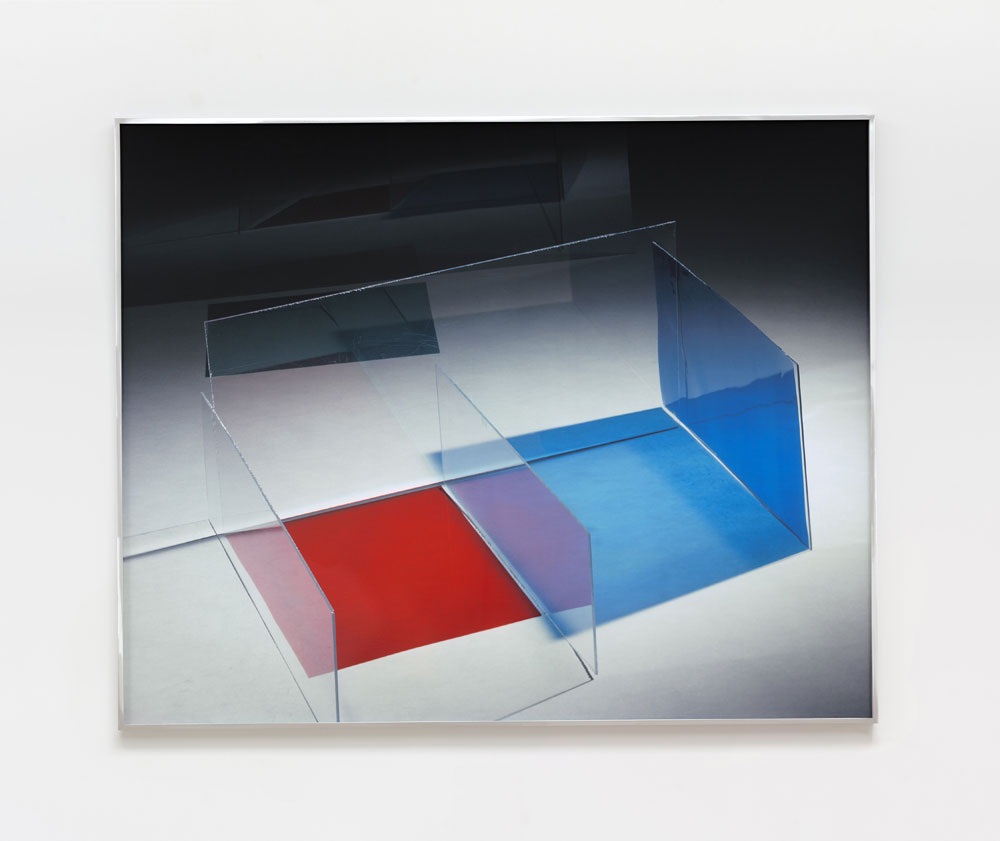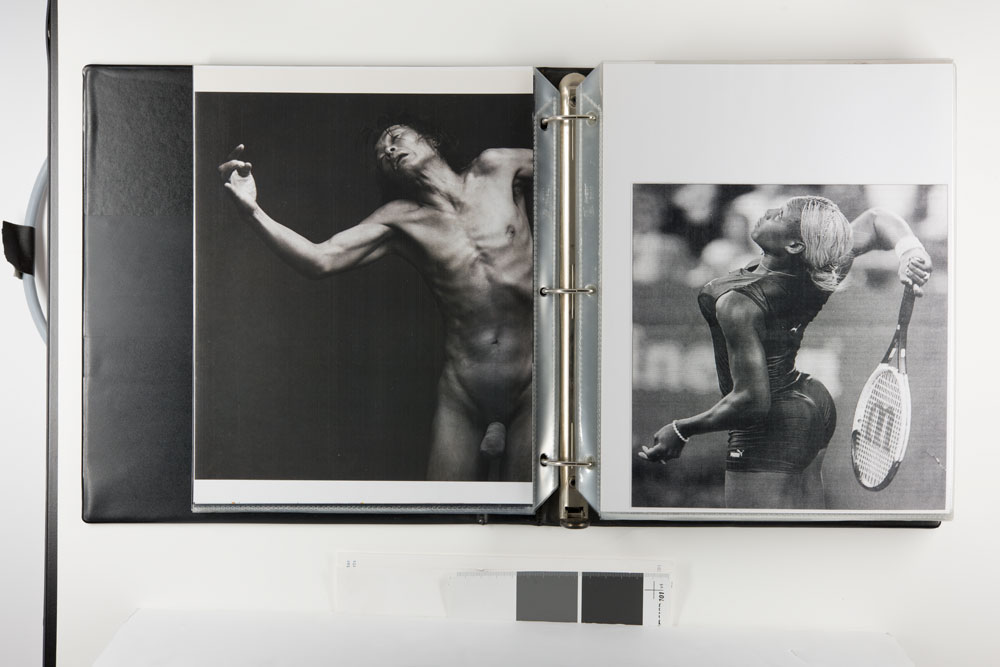Critic's Guide: Los Angeles
Jibade-Khalil Huffman, Barbara Kasten, Mélanie Matranga, and more: a guide to the best current shows on the west coast
Jibade-Khalil Huffman, Barbara Kasten, Mélanie Matranga, and more: a guide to the best current shows on the west coast


Barbara Kasten: ‘“I want the eyes to open” – Josef Albers’
Hannah Hoffman Gallery
23 July – 2 September
Best known for convincing glowing lights, prismatic angles and graphics in high relief – and high brilliance – to cooperate, even if only momentarily, in her photography, Barbara Kasten’s half-century-worth of work has only recently received its due applause.
Her neo-Constructivist intersections of light, shadow, and material have been caught on film, video, and on carefully constructed sets. The artist’s floating abstractions continue in her recent body of work ‘Elementals’, which paraphrases the De Stijl chapter of art history in their bold primary-color palette and razor-sharp right angles. Colourless window screens press against each other to ghostlike effect in ‘Double Negatives’, images whose reluctance to identify as either positive or negative photographs proves visually unsettling. The series ‘Constructs’, made between the late ’70s to early ’80s, show more stable compositions that flex their meticulous intricacies and dynamic precisions on sensitive, volatile Polaroid film. Bookending a citywide presentation, her first exhibition at Hannah Hoffman complements ‘Stages’, her concurrent survey at MOCA.

'Made in L.A. 2016: a, the, though, only'
Hammer Museum
12 June – 28 August
Presenting excerpts of 26 artists’ practices in a generous and considered display instead of compiling a survey attempting to summarize the aesthetic output of an immensely uneven, increasingly international city, the third iteration of LA’s biennial, organized by the Hammer’s Aram Moshayedi and the Renaissance Society’s Hamza Walker, highlights facets of the city’s visual culture which less often see the light. While artists such as Sterling Ruby and Silke Otto-Knapp deliver on the grand tradition of Hollywood-blockbuster film sets, and Martine Syms and Margaret Honda borrow and manipulate such movies’ high production values, space is cleared for the city’s Middle Eastern diaspora, as in Lebanese artist Huguette Caland’s room of blushful caftans and deliciously overripe forms on canvas, made in LA since the early ’80s. Elsewhere Dena Yago, Joel Holmberg and Todd Gray build with conceptual tools, an indirect legacy from a number of the city’s renowned art schools; and Kenzi Shiokava, who has long sidestepped the bleaching sun for the shadows, taking 40 years to finish his Various Sculptures –anthropomorphic totems embued with shy vitality and radiant warmth – receives his major premiere, at the age of 78.

Mélanie Matranga, ‘Feeling Myself’, featuring works by Carlotta Bailly Borg, Dora Diamant and Antoine Trapp
Karma International
25 May – 20 August
French artist Mélanie Matranga drapes the rooms of Karma International with a web of her trademark putty-colored scraps of fabric that ensnare you in the intimacy shared by confidants. Incorporating individual works by friends and fellow artists Carlotta Bailly Borg, Dora Diamant and Antoine Trapp, the assemblages are materially unremarkable: jersey fabric; spherical Chinese lanterns; swatches of red wool, skeletal after a couple of choice words have been cut out of them (Always Come, all works 2016), and their partial relief: the letters ME, traced out of black wool, stuffed and slumped in the corner (Coy).
Navigating within this emotional architecture is to tread through the faded, sentimental snapshots of friends, lovers and co-conspirators, screen-printed onto T-shirts and strung from the ceiling by a stopgap fabric grid held together by quick knots (ME in Beige), as much as it is to let oneself sink into the messiness of an illicit embrace.

Jibade-Khalil Huffman, ‘Verse Chorus Verse’
Los Angeles Contemporary Exhibitions (LACE)
29 June – 14 August
Created during a residency at LACE, Jibade-Khalil Huffman’s group of static and moving images continue the artist and poet’s practice of visualizing verbal riddles and doublespeak.
Directing an oblique narrative from young groups of friends socializing – the film moves across violet-laced screens affixed to the walls and the centre of the gallery floor interspersed with colourless scenes from retro kitchens – the exhibition as a whole misleads consumption of content and advertisement, using feature-film techniques against themselves: tracking shots lead to a story’s dead end, while marketing campaigns hide behind the stylings of a high-charting music video. Following multiple strains synthesized into one cacophonous soundtrack, when absorbed together, it becomes apparent that if we can look to a film to see something outside of ourselves, yet expect to recognize ourselves in a commercial, it’s inevitable that these voices will hear and begin to imitate each other.

‘Tinseltown in the Rain: The Surrealist Diaspora in Los Angeles 1935–1969’
Richard Telles Fine Art
9 July – 13 August
Unlikely as it may sound, the Parisian surrealism of the 1920s produced a parallel, though much smaller, looser, movement in Los Angeles, one whose stylistic repercussions spanned several decades. Shuffling the polished images churned out by Hollywood, superficial depictions of mysticism and spirits – what might be embodied by crystals and shamanic elixirs in LA today – and glittering mirages of unsettling scenes, the city’s perpetual dream-inducing state has provided the optimal climate for surrealistic tendencies.
The historical origins of surrealism are harnessed in this concise yet distinctive survey, curated by LA artist Max Maslansky. Much of the work here once belonged in the private collection of Walter and Louise Arensberg – collectors once advised by Marcel Duchamp. Kenneth Anger, Maya Deren, Claire Falkenstein, Oskar Fischinger and Alexander Hammid are among the many represented – a number of whom would eventually share a workplace: The Walt Disney studios.

Mark A. Rodriguez, ‘Earth Day af’
Park View Gallery
23 July – 10 September
Stuff is piled high in every corner of this apartment gallery, where Mark A. Rodriguez has stockpiled recent treasures and antiquities. Amassing a library of amateur recordings of Grateful Dead concerts, on cassette tapes whose sun-faded spines have scrawled dates ranging from 1965 to 1995, the collection asserts its maturity with a custom-built, eight-foot-tall mahogany storage system. 1st Gen (2010–16) overflows to 2nd Gen (2010–ongoing), where recordings, intensely bartered by Deadheads, are so abundant that they are boxed up under the kitchen table. Clumsy statements of personal wealth and uncertainly refined taste extend to a couple of wooden tables, modeled after refined objects of design, but who lost their prestige once they’d entered industrial manufacture. Similarly, a surplus of ‘Common Lamps’, glowing Edison bulbs housed in copper constructs undergone a range of treatments – from paper-thin, hammered planes to rolls of pennies – greedily aggregate the stylish, aspirational metal of the moment.

Pedro Barateiro and Quinn Latimer, ‘Live from the West’
REDCAT
9 July – 18 September
Contending Western military, capitalist, or ecological mismanagement has been a particular artistic call in the past years, and Lisbon artist Pedro Barateiro and American poet Quinn Latimer have collaborated on a multimedia address. Orienting itself paradoxically both toward the fabled American West, which culminates in the Pacific coast on which Los Angeles rests, and the greater West, whose advancing political and economic instabilities threaten its mythical authority, the gallery-spanning installation of expansive surfaces – organically shaped settees (Rumour Bench I and II, all works 2016) and floors of polished concrete, scribbled over with snaking electrical cords; towering abstract black and white matte photographs of charcoal paint frosting the lustrous white linoleum floor of Barateiro’s studio – coolly reflect Latimer’s measured recital of her poems, her voice moving between an intermittent network of small speaker-box cubes, each mounted on its own industrial tripod. The room is studded with tactile objects that fit in the hand – a tin mug, scraps of denim, a bit of particleboard; outliers of a detached grayscale network, each one held against the wall. A protest is not always a shout.
Lead image: Dena Yago, Do you ever feel like a plastic bag?, 2014, digital c-type print mounted on aluminium and metal grate, 70 x 100 cm. On View at 'Made in L.A. 2016: a, the, though, only', Hammer Museum






















